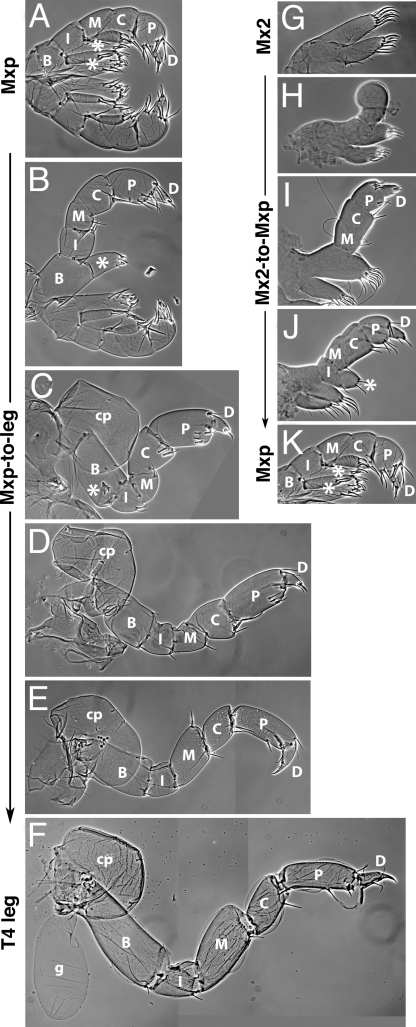Fig. 4.
Mxp-to-leg and Mx2-to-Mxp transformations resulting from PhUbx misexpression. (A) Bilateral pair of wild-type Mxp/T1 appendages, with characteristic segmented endopod, including ischium and basis with characteristic endites (asterisks). (B–E) T1 appendages with transformations of increasing severity, resulting from misexpression of PhUbx in mosaic embryos. (B) Bilateral pair of Mxp/T1 appendages with unilateral phenotype, including loss of the endite on the ischium, and elongation of endopod segments (especially basis and propodus). (C) More severe transformation of Mxp/T1 toward a T2/3-type leg, including loss of the endite on the ischium, reduction of the endite on the basis (folded on the basis, asterisk), the appearance of a coxal plate, and the shapes of the leg segments, which are characteristic of T2/3 legs. (D) Almost complete transformation of Mxp to T2/3-type appendage. Compared to the appendages in previous panels, this appendage was positioned more laterally and separated from the wild-type Mxp on the contralateral side, a characteristic of T2–T8 appendages. (E) Transformation of Mxp to T4/5-type appendage. T4 characteristics include the narrower propodus and characteristic shapes of the merus and carpus. (F) Wild-type T4 leg. (G) Wild-type Mx2 appendage. (H–J) Mx2 appendages with transformations of increasing severity, resulting from misexpression of PhUbx in mosaic embryos. (H) Mx2 with lateral outgrowth. (I) Mx2 with segmented Mxp-like endopod, comprising dactyl, propodus, carpus, and merus. Proximal portions of the appendage retain the characteristics of Mx2. (J) Mx2 with segmented endopod, including ischium with Mxp-like endite (asterisk). The proximal podomere retains the characteristics of Mx2, suggesting that the normal Mx2 appendages represent protopodal endites. (K) Wild-type Mxp/T1 appendage, as in A. All panels show cuticle preparations of dissected hatchling appendages at the same magnification. B, basis; I, ischium; M, merus; C, carpus; P, propodus; D, dactyl; cp, coxal plate; g, gill.

